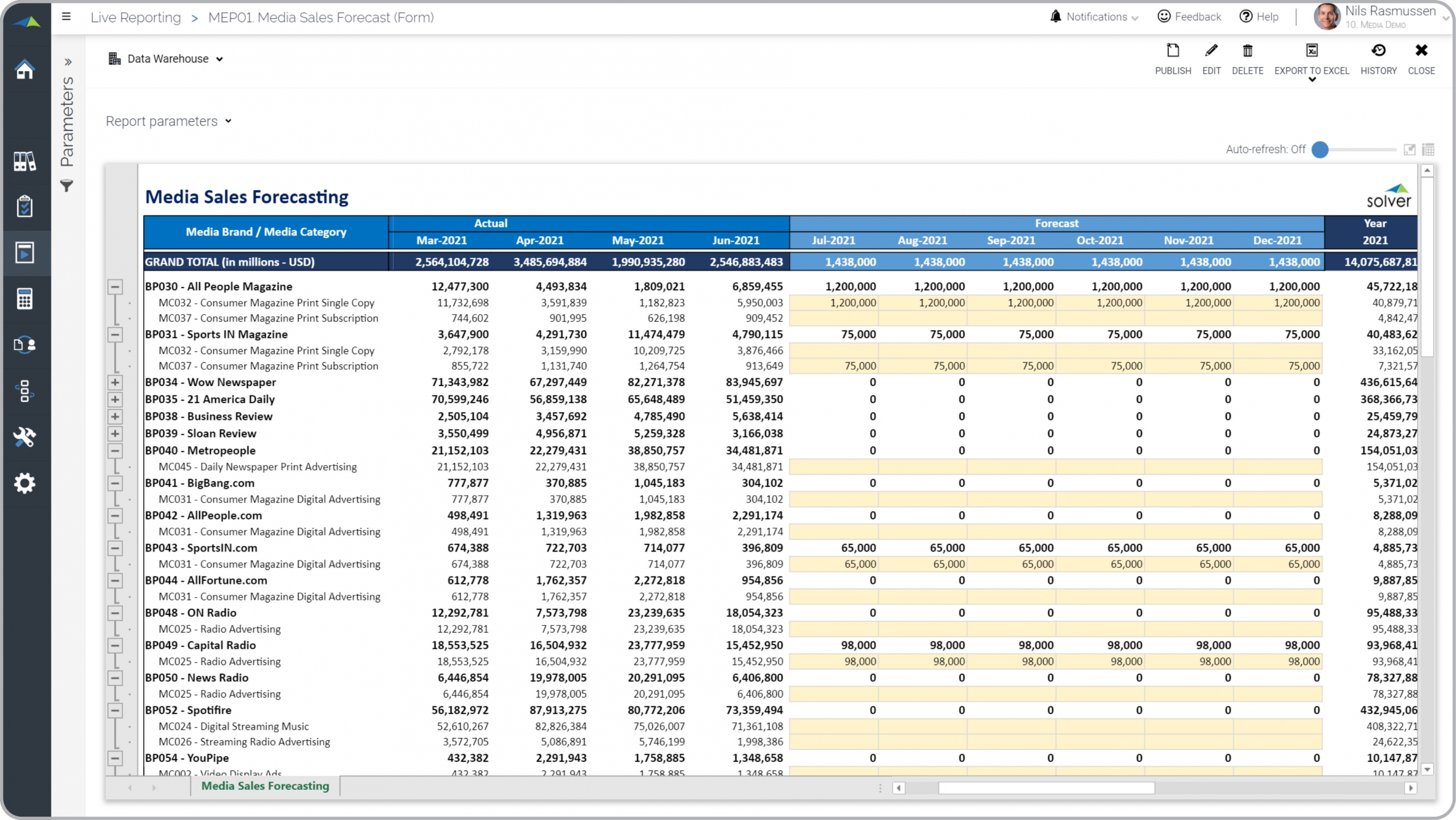Sales Forecast Model for Media Companies
What is
a
Sales Forecast Model for Media Companies
? Sales Forecast Models are considered planning tools and are used by sales and budget managers to estimate the revenue from subscriptions, advertising, etc. for the remainder of the year. Some of the main functionality in this type of input template is that it automatically displays the actual data for the historical months and opens the remainder periods of the year for input. The rows list the media categories (print copies, subscriptions, advertising, etc.) by media brand. The bottom of the form shows the grand total actual and forecasted revenues by month. You find an example of this type of input template below.
Purpose of
Sales Forecast Input Models Media companies use Sales Forecast Input Models to speed up and simplify data entry of sales forecasts. When used as part of good business practices in Sales and Financial Planning & Analysis (FP&A) departments, a company can improve its forecasting accuracy and related sales tactics, and it can reduce the chances that overspending that are caused by over-optimistic revenue plans occurs.
Example of a
Sales Forecast Input Model Here is an example of a Sales Forecast Input Template with actual data and data entry for remaining months of the year. [caption id="" align="alignnone" width="2560"]
 Example of a Sales Forecast Model for Media Companies[/caption] You can find hundreds of additional examples
here
Who Uses This Type of
Input template
? The typical users of this type of input template are: VP of Sales, Sales Managers, Budget Managers.
Other Reports Often Used in Conjunction with
Sales Forecast Input Models Progressive sales and Financial Planning & Analysis (FP&A) departments sometimes use several different Sales Forecast Input Models, along with profit & loss budgets, payroll budgets, capex budgets, variance reports, financial dashboards, budget dashboards and other management and control tools.
Where Does the Data for Analysis Originate From? The Actual (historical transactions) data typically comes from enterprise resource planning (ERP) systems like: Microsoft Dynamics 365 (D365) Finance, Microsoft Dynamics 365 Business Central (D365 BC), Microsoft Dynamics AX, Microsoft Dynamics NAV, Microsoft Dynamics GP, Microsoft Dynamics SL, Sage Intacct, Sage 100, Sage 300, Sage 500, Sage X3, SAP Business One, SAP ByDesign, Acumatica, Netsuite and others. In analyses where budgets or forecasts are used, the planning data most often originates from in-house Excel spreadsheet models or from professional corporate performance management (CPM/EPM) solutions.
What Tools are Typically used for Reporting, Planning and Dashboards? Examples of business software used with the data and ERPs mentioned above are:
Example of a Sales Forecast Model for Media Companies[/caption] You can find hundreds of additional examples
here
Who Uses This Type of
Input template
? The typical users of this type of input template are: VP of Sales, Sales Managers, Budget Managers.
Other Reports Often Used in Conjunction with
Sales Forecast Input Models Progressive sales and Financial Planning & Analysis (FP&A) departments sometimes use several different Sales Forecast Input Models, along with profit & loss budgets, payroll budgets, capex budgets, variance reports, financial dashboards, budget dashboards and other management and control tools.
Where Does the Data for Analysis Originate From? The Actual (historical transactions) data typically comes from enterprise resource planning (ERP) systems like: Microsoft Dynamics 365 (D365) Finance, Microsoft Dynamics 365 Business Central (D365 BC), Microsoft Dynamics AX, Microsoft Dynamics NAV, Microsoft Dynamics GP, Microsoft Dynamics SL, Sage Intacct, Sage 100, Sage 300, Sage 500, Sage X3, SAP Business One, SAP ByDesign, Acumatica, Netsuite and others. In analyses where budgets or forecasts are used, the planning data most often originates from in-house Excel spreadsheet models or from professional corporate performance management (CPM/EPM) solutions.
What Tools are Typically used for Reporting, Planning and Dashboards? Examples of business software used with the data and ERPs mentioned above are:
- Native ERP report writers and query tools
- Spreadsheets (for example Microsoft Excel)
- Corporate Performance Management (CPM) tools (for example Solver)
- Dashboards (for example Microsoft Power BI and Tableau)
Corporate Performance Management (CPM) Cloud Solutions and More Examples
July 21, 2021
TAGS:
Reporting,
Solver,
print,
report writer,
Microsoft,
template,
practice,
Acumatica,
Netsuite,
TV,
streaming,
Finance,
planning,
GP,
category,
Business Central,
excel,
radio,
ax,
forecast,
Budget,
Dynamics 365,
sales forecast,
budgeting,
input model,
Cloud,
Software,
Tableau,
SAP,
example,
media,
best,
Sage,
BC,
D365,
NAV,
Intacct,
broadcast,
brand,
online,
CPM,
report,
SL,
Management,
dynamics,
sales budget,
Power BI

